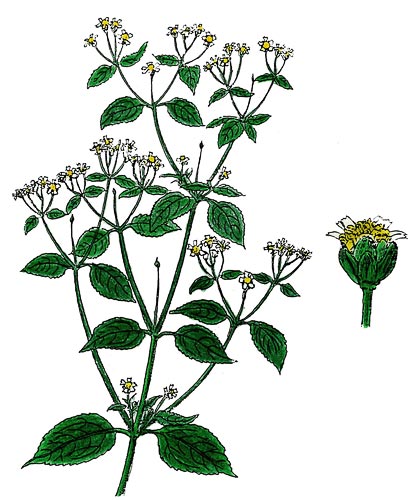Weeds
Galinsoga parviflora Cav. - Gallant Soldier, Little-Flower Quickweed, Kew Weed.
Systematic position.
Family Asteraceae, genus Galinsoga Ruiz et Pav.Biological group.
Annual early spring weed.Morphology and biology.
Plant reaches 10-100 cm in height, is covered with sparse, fine, dense (in upper part), accumbent, simple hairs, with admixture of glandular hairs. Stalk is straight, usually ramified from the base. Roots filamentous. Leaves opposite, ovate or elongate-ovate, pointed, petiolate, sinuous or with blunt denticles along edges. Anthodia numerous, located on thin stems unequal in length in friable semi-umbels up to 3 mm in diameter. Leaflets are involucre ovate, membranous at edges. Ligular flowers about 3 mm in length. Hemicarps 1.0-1.5 mm in length, with fine, light pubescence. Marginal hemicarps triquetrous, inner ones quadri- or pentahedral, with indistinct grooves, dark gray, sometimes almost black. Pappus of marginal hemicarps consist of fine, fragile setae; median ones consist of 8-20 white, elongate-lanceolate, ciliate membranes that break off from the ring welt. Blossoming occurs in July-September. One plant produces up to 300,000 seeds. Weight of 1000 seeds is 0.21 g. Vegetation period lasts 30-45 days. Spread by pappose seeds, which are carried by wind.Distribution.
South and North America, the Caucasus, the southern Far East, Central Asia, southern Scandinavia, Central and Atlantic Europe, the Mediterranean, Asia Minor, Japan, China, Australia, and Africa.Ecology.
Prefers shady, damp places and light soil. Germinating capacity of fresh seeds is 28-49%. The minimum temperature for seed germination is +6-8°C; optimum is +16-30°C. Variable temperatures promote germination of old hemicarps but have little influence on fresh ones. Alternation of dry and humid conditions substantially raises germinating capacity of both fresh and old hemicarps. Seeds of the weed germinate at depths of no more than 2-3 cm. Light greatly influences germination. Summer and autumn shoots do not winter and perish at temperatures of 4.2°C.Economic value.
Considerably suppresses carrots, parsley, beet, potato, and tomatoes; litters grain crops. Control measures include autumn plowing, pre-sowing cultivation, timely sowing, inter-row tillage in tilled crops, maintenance of crop rotation, and use of herbicides, if necessary.Related references.
Chesalin, G.A. 1975. Weeds and their control. Moscow: Kolos. 256 pp. (In Russian)Keller, B.A., Lyubimenko, V.N., Maltsev, A.I., Fedtshenko, B.A., Shishkin, B.K., Rodzevich, R.Yu., Kamenskii, K.V., eds. 1935. Weed plants of the USSR. Moscow & Leningrad: AN USSR. V.4. 414 pp. (In Russian)
Komarov, V.L., ed. 1959. Flora of the USSR. Moscow & Leningrad: AN SSSR. V. 25, 231 pp. (In Russian)
Prokudin, Yu.N., ed. 1987. Keys to vascular plants of Ukraine. Kiev: Naukova dumka, 547 pp. (In Russian)
Veselovs.kii, I.V., Lisenko, A.K., Man.ko, Yu.P. 1988. Atlas-synopsis of weeds. Kyiv: Urozhai. 64 pp. (In Ukrainian)


